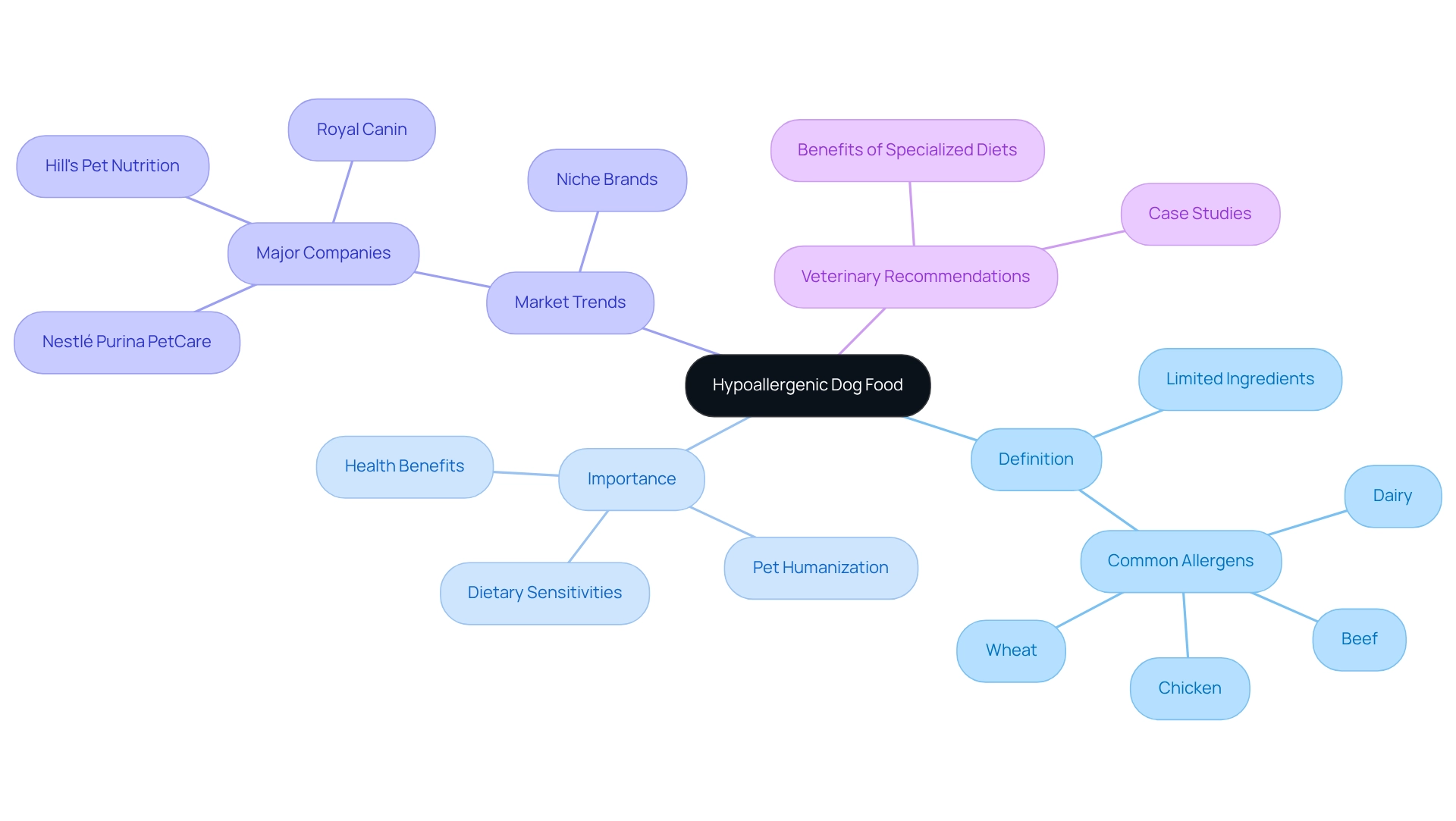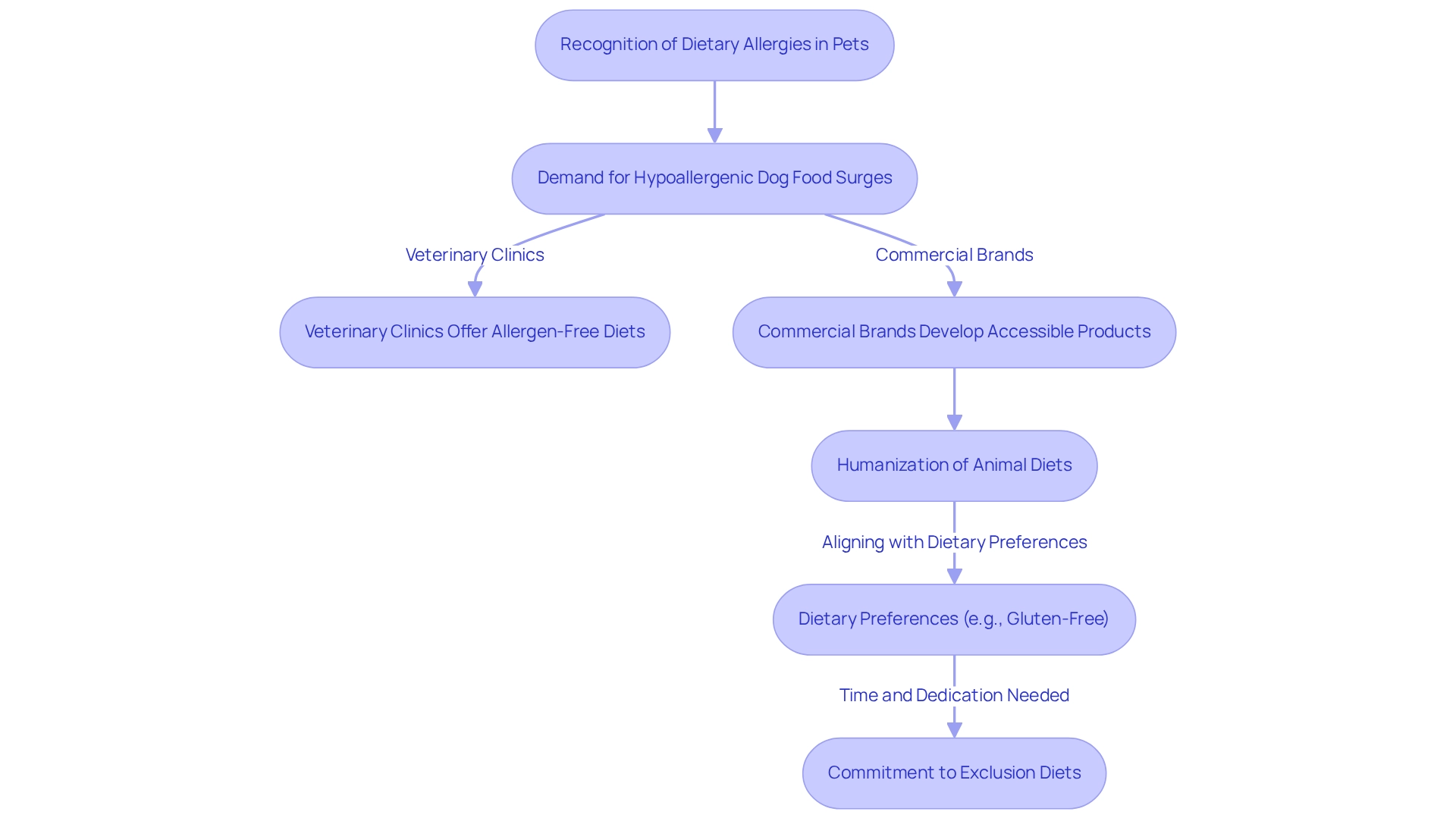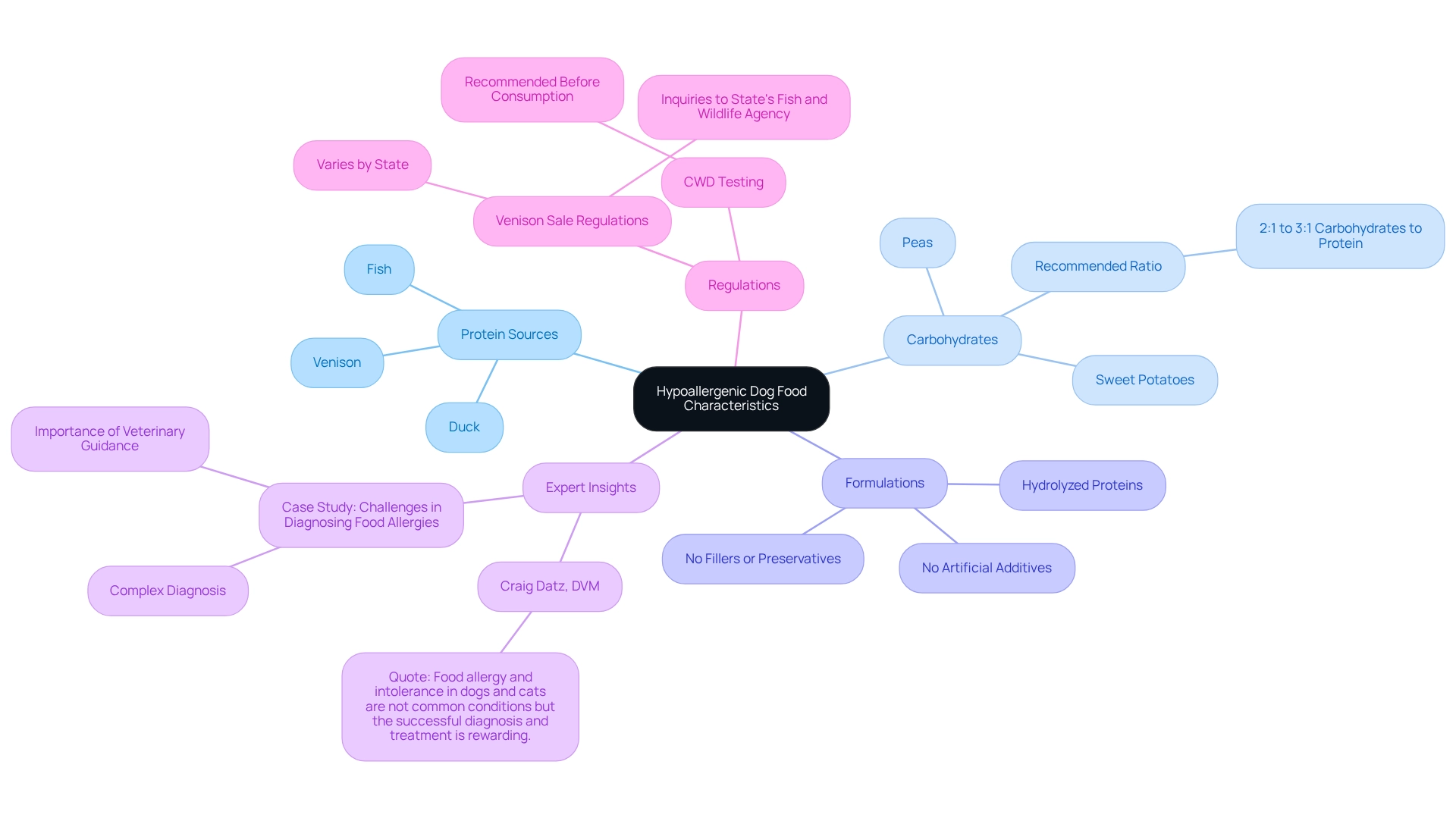
Understanding Hypoallergenic Dog Food: Benefits and Key Features
Overview
Hypoallergenic dog food offers significant benefits for dogs with dietary sensitivities, helping to minimize allergic reactions through limited ingredients and the avoidance of common allergens.
For many pet owners, the struggle to see their beloved companions suffer from itching and gastrointestinal distress can be heart-wrenching.
These specialized diets not only alleviate such symptoms but also enhance overall health and vitality.
Many pet owners have shared their heartfelt success stories, recounting remarkable improvements in their pets’ well-being after making the switch to hypoallergenic options.
This transformation can bring immense relief and joy, reinforcing the importance of quality care for our furry friends.
Introduction
In a world where dogs are beloved family members, ensuring their health and happiness is more important than ever. Many pet owners are understandably concerned about the rising prevalence of food allergies among their furry companions.
Hypoallergenic dog food has emerged as a compassionate solution, offering a way to address these worries. These specially formulated diets are designed to minimize allergic reactions by using limited ingredients and avoiding common allergens, providing a safe and nutritious alternative for dogs with sensitivities.
As the pet food market evolves, more brands are stepping up to meet this pressing need, leading to innovative formulations that prioritize quality and ethical sourcing.
This article explores the significance of hypoallergenic dog food, its historical development, key characteristics, and the health benefits it offers, equipping pet owners with the knowledge needed to make informed dietary choices for their cherished pets.
Defining Hypoallergenic Dog Food: What It Is and Why It Matters
Hypoallergenic dog food is thoughtfully crafted to minimize the chances of allergic reactions in our beloved canines. It typically features limited ingredients and consciously avoids common allergens such as beef, chicken, dairy, and wheat. The primary goal of hypoallergenic dog food is to offer a safe and nutritious option for dogs with dietary sensitivities or allergies, ensuring they receive essential nutrients without triggering adverse reactions. Understanding hypoallergenic dog food is vital for caring guardians who wish to safeguard their companions’ health and well-being, especially for those with known allergies or sensitivities.
The importance of hypoallergenic dog food for allergen-free canine nutrition cannot be overstated, especially for busy pet owners striving to protect their pets’ health. Recent studies indicate a significant rise in dietary allergies among dogs, with heightened awareness driving the demand for hypoallergenic dog food alternatives. This trend is further propelled by the growing phenomenon of pet humanization, where pet owners increasingly seek high-quality, ethically sourced nourishment for their furry friends.
The market for allergy-friendly pet food is flourishing, characterized by a commitment to ingredient quality and ethical sourcing. Prominent companies, such as Nestlé Purina PetCare, Hill’s Pet Nutrition, and Royal Canin, have broadened their offerings to include hypoallergenic dog food, while niche brands are emerging that focus on high-quality allergy-friendly products. This competitive landscape nurtures innovation and product development, ensuring that pet owners can access effective solutions for their pets’ dietary needs.
Veterinarians often recommend hypoallergenic dog food for canines showing signs of allergies, emphasizing the benefits of these specialized diets in alleviating symptoms and enhancing overall well-being. As Ryoko Tanaka, Head of Planning at Asset Services UK, observes, “Hypoallergenic Dog Food Market Share & Trends by Product, Application, and Region – Insights to 2033” underscores the growing significance of these diets in the pet care sector. Real-life examples illustrate the effectiveness of hypoallergenic dog food in managing allergies, with many pet owners reporting remarkable improvements in their pets’ health after making the switch to hypoallergenic dog food diets.
In conclusion, understanding hypoallergenic dog food is crucial for pet owners, especially those with dogs known to have allergies or sensitivities. By choosing the right allergy-friendly diet, busy professional animal guardians can enhance their companions’ quality of life and ensure they thrive without the discomfort of allergic reactions.

The Origins of Hypoallergenic Dog Food: A Historical Perspective
The emergence of hypoallergenic dog food stems from a growing recognition of dietary allergies in our beloved pets, particularly noted in the late 20th century. As veterinarians and caring pet owners began to observe signs of allergies—like itching, gastrointestinal discomfort, and skin irritations—the demand for hypoallergenic dog food to alleviate these issues surged.
Initially, allergen-free diets were primarily available through veterinary clinics. However, as awareness expanded, commercial brands stepped in, creating and promoting these products, thereby making them more accessible to pet owners through various channels, including pet specialty shops and online platforms.
Today, hypoallergenic dog food has become a well-established category within the pet food industry, reflecting a deeper understanding of our pets’ health and nutritional needs. The rise of hypoallergenic diets aligns with the broader trend of humanization in animal care, where our furry companions are increasingly seen as family members. This perspective encourages pet owners to scrutinize their pets’ diets more closely, seeking options like hypoallergenic dog food that resonate with their own dietary preferences, such as gluten-free choices.
The case study titled ‘Humanization of Animal Diets’ underscores this trend, concluding that the humanization of animal diets has led to heightened awareness regarding their nutritional requirements, prompting owners to pursue diets that mirror their own dietary values.
Research suggests that the duration for feeding an exclusion diet to address dermatological symptoms typically spans 4 to 8 weeks or even longer, highlighting the commitment needed from pet owners. As experts note, ‘the process can be slow and time-consuming; to be effective, it takes dedication, and owners may not see immediate results.’ This emphasizes the importance of patience and persistence in managing allergies in pets.
The rise in dietary allergies has not only spurred the development of hypoallergenic dog food but has also created significant opportunities within the pet nutrition market, reflecting an increasing awareness of animal health and nutrition.

Key Characteristics of Hypoallergenic Dog Food: Ingredients and Formulations
Hypoallergenic dog food is thoughtfully crafted with novel protein sources like duck, venison, or fish, which are less likely to trigger allergic reactions in our beloved pets. These diets often include easily digestible carbohydrates such as sweet potatoes or peas, steering clear of common grains that can lead to sensitivities. A helpful guideline for a homemade dog diet is a 2:1 to 3:1 ratio of carbohydrates to protein, assisting pet owners in balancing their dog’s nutritional needs. Many formulations designed to minimize allergens also feature hydrolyzed proteins, broken down into smaller elements that are less likely to provoke an immune response. Furthermore, the absence of artificial additives, fillers, and preservatives is a hallmark of quality dog food, ensuring that our furry companions receive a diet that is both safe and nourishing.
Expert opinions underscore the significance of introducing new protein sources in allergy-friendly diets. As Craig Datz, DVM, wisely notes, ‘Food allergy and intolerance in dogs and cats are not common conditions but the successful diagnosis and treatment is rewarding.’ This insight emphasizes the importance of addressing dietary concerns with professional guidance, fostering a sense of reassurance for pet owners, particularly as real-life examples of hypoallergenic dog food illustrate the effectiveness of these carefully selected ingredients in managing allergies. For instance, a case study titled ‘Challenges in Diagnosing Food Allergies’ highlights the complexities involved in accurately diagnosing food allergies, reinforcing the necessity of veterinary expertise in choosing appropriate diets. By understanding these complexities, pet owners can appreciate the value of tailored nutrition for their dogs, nurturing their well-being.
Additionally, it is essential for pet owners to be aware that regulations for venison sale can vary by state, and inquiries should be directed to the state’s fish and wildlife agency. Testing for CWD, a serious prion illness affecting deer, is strongly recommended prior to consumption, ensuring the safety of the protein sources utilized in special diets. This diligence reflects the caring commitment to our pets’ health and happiness.

Health Benefits of Hypoallergenic Dog Food: Supporting Your Pet’s Well-Being
The health advantages of hypoallergenic dog food are truly significant for our beloved pets who may be grappling with food allergies or sensitivities. It’s heart-wrenching to see them struggle with symptoms like itching, gastrointestinal distress, and skin irritations. By eliminating common allergens, these specialized diets can help alleviate such discomfort, leading to a happier and healthier life for your furry companions.
Moreover, allergy-friendly diets often enhance digestion and nutrient absorption, which can invigorate their energy levels and overall vitality. Many pet owners share heartwarming stories of how their pets’ fur quality and skin health have dramatically improved after making the switch to these gentle alternatives.
Ultimately, selecting hypoallergenic dog food is not merely a dietary change; it is a loving choice that promotes your pet’s long-term health and well-being, demonstrating how much you care.

Conclusion
The significance of hypoallergenic dog food truly resonates in today’s pet care landscape, especially as more pet owners face the heart-wrenching reality of food allergies affecting their beloved companions. These specially formulated diets provide a vital solution for those seeking to enhance their pets’ health and overall well-being. By minimizing allergic reactions through limited ingredients and steering clear of common allergens, hypoallergenic dog food emerges as a safe and nourishing option for dogs experiencing sensitivities.
The evolution of hypoallergenic diets mirrors a growing awareness of pet health, significantly influenced by the humanization of pets. As pet owners become increasingly attuned to their dogs’ nutritional needs, the demand for high-quality, ethically sourced hypoallergenic options continues to flourish. This rising trend has sparked innovation, resulting in a diverse array of formulations tailored specifically for dogs suffering from allergies, ensuring that pet owners have access to effective dietary solutions.
Key characteristics of hypoallergenic dog food, such as the inclusion of novel protein sources and easily digestible carbohydrates, play an essential role in alleviating the distressing symptoms associated with food allergies. Moreover, the health benefits linked to these diets—ranging from improved digestion to a vibrant coat condition—highlight the importance of making informed dietary choices for our cherished pets.
In conclusion, choosing hypoallergenic dog food represents a compassionate approach to managing food allergies and fostering a healthier lifestyle for our furry friends. We encourage pet owners to consult with veterinarians to select the most suitable diet, ensuring that their companions thrive free from the discomfort of allergic reactions. As the pet food market continues to evolve, the future for hypoallergenic options appears bright, paving the way for happier, healthier dogs.

